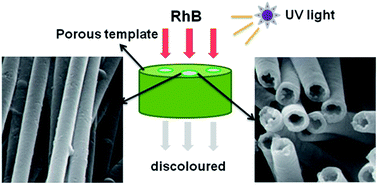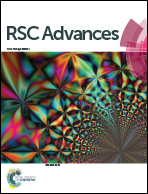Polyoxometalate-based layered nano-tubular arrays: facile fabrication and superior performance for catalysis†
Abstract
Keggin-type polyoxoanion PW12O403−-containing one-dimensional nano-tubular arrays, with the structure polyethylenimine/polystyrenesulfonate/(poly(allylammonium)/polystyrenesulfonate)3(poly(allylammonium)/PW12O403−)8, were fabricated as a prototype using a layer-by-layer deposition technique in porous anodic aluminum oxide and polycarbonate templates with a pore diameter of 200 nm, and characterized by IR, UV-vis and SEM. The resulting nano-tubes have a uniform diameter of 180 ± 20 nm and a uniform wall thickness of 30 ± 5 nm. These arrays have shown superior performance in the UV light irradiated photo-degradation of Rhodamine B (selected as a representative dye) under mild conditions with respect to both the catalytic efficiency and operating convenience due to the confinement within the nano-tubes both in the latitudinal and radial direction. Remarkably, the catalytic activity of the nano-tubular arrays could be recovered by means of simple immersion in the polyoxoanion solution when the catalytic reactivity became reduced, which is vital in view of practical applications. The total organic carbon content changes and GC-MS measurements were conducted to identify the degradation products. The hydroxyl radical mechanism was found to be adopted by the photo-degradation reaction.


 Please wait while we load your content...
Please wait while we load your content...